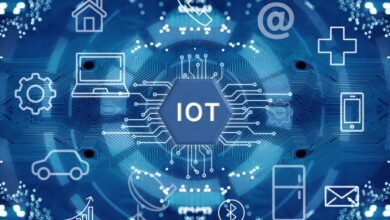The Role of Edge Computing in Germany’s IoT Infrastructure
In this article, we will explore the role of edge computing in Germany’s IoT infrastructure, its significance, and how it is shaping the future of industries across the country.

The rapid evolution of technology has transformed the way we interact with the world, and Germany stands at the forefront of this digital revolution. As the Internet of Things (IoT) continues to expand, the need for efficient data processing and real-time analytics has become paramount. This is where edge computing plays a pivotal role. In this article, we will explore the role of edge computing in Germany’s IoT infrastructure, its significance, and how it is shaping the future of industries across the country.
Understanding Edge Computing and IoT
What is edge computing?
Edge computing is a distributed computing paradigm that brings data processing closer to the source of data generation, such as IoT devices, sensors, or local servers. Unlike traditional cloud computing, where data is sent to centralized data centers for processing, edge computing processes data at the “edge” of the network. This reduces latency, enhances speed, and ensures real-time decision-making.
What is IoT?
The Internet of Things (IoT) refers to a network of interconnected devices that collect, exchange, and analyze data to automate processes and improve efficiency. From smart homes to industrial automation, IoT is revolutionizing industries worldwide.
The Intersection of Edge Computing and IoT
The integration of edge computing with IoT is a game-changer. By processing data locally, edge computing addresses the limitations of cloud-based IoT systems, such as latency, bandwidth constraints, and data privacy concerns. This synergy is particularly crucial for Germany, a country known for its advanced manufacturing and industrial sectors.
The Role of Edge Computing in Germany’s IoT Infrastructure
Germany, often referred to as the “engine of Europe,” is a global leader in industrial innovation. The country’s IoT infrastructure is a cornerstone of its Industry 4.0 initiative, which aims to digitize and automate manufacturing processes. Here’s how edge computing is playing a transformative role in Germany’s IoT landscape:
Enhancing Real-Time Data Processing
In industries like automotive manufacturing, where precision and speed are critical, edge computing enables real-time data processing. For instance, sensors on a production line can detect anomalies and trigger immediate corrective actions without waiting for cloud-based analysis. This reduces downtime and improves operational efficiency.
Reducing Latency and Bandwidth Usage
Germany’s IoT infrastructure supports millions of connected devices, from smart meters to autonomous vehicles. Transmitting all this data to centralized cloud servers can overwhelm network bandwidth and cause delays. Edge computing mitigates this by processing data locally, ensuring faster response times and reducing the load on network infrastructure.
Improving Data Security and Privacy
Data privacy is a top priority in Germany, thanks to stringent regulations like the General Data Protection Regulation (GDPR). Edge computing enhances data security by minimizing the need to transmit sensitive information over long distances. This localized approach ensures that critical data remains within the premises, reducing the risk of breaches.
Supporting Autonomous Systems
Germany is a pioneer in autonomous vehicle technology and smart city initiatives. Edge computing is essential for these applications, as it enables real-time decision-making. For example, self-driving cars rely on edge computing to process sensor data instantly, ensuring safe and efficient navigation.
Enabling Predictive Maintenance
In Germany’s manufacturing sector, predictive maintenance is a key application of IoT. Edge computing allows factories to analyze equipment data in real-time, predicting potential failures before they occur. This minimizes unplanned downtime and extends the lifespan of machinery.
Key Industries Leveraging Edge Computing in Germany
The role of edge computing in Germany’s IoT infrastructure is evident across various industries. Here are some sectors where this technology is making a significant impact:
Automotive Industry
Germany is home to some of the world’s leading automotive manufacturers, such as BMW, Volkswagen, and Mercedes-Benz. Edge computing is integral to the development of connected cars and autonomous driving systems. By processing data locally, edge computing ensures that vehicles can make split-second decisions, enhancing safety and performance.
Manufacturing and Industry 4.0
Germany’s Industry 4.0 initiative aims to create smart factories that leverage IoT and automation. Edge computing plays a crucial role in this vision by enabling real-time monitoring and control of production processes. This results in higher productivity, reduced waste, and improved quality.
Healthcare
The healthcare sector in Germany is increasingly adopting IoT devices, such as wearable health monitors and remote patient monitoring systems. Edge computing ensures that patient data is processed quickly and securely, enabling timely medical interventions and improving patient outcomes.
Energy and Utilities
Germany is a leader in renewable energy, with a strong focus on smart grids and energy management systems. Edge computing helps optimize energy distribution by analyzing data from sensors and IoT devices in real-time. This ensures efficient energy usage and reduces costs.
Smart Cities
German cities like Berlin and Munich are embracing smart city technologies to improve urban living. Edge computing supports applications such as traffic management, waste management, and public safety by enabling real-time data analysis and decision-making.
Challenges and Opportunities in Germany’s Edge Computing Ecosystem
While the role of edge computing in Germany’s IoT infrastructure is undeniable, there are challenges that need to be addressed to fully realize its potential.
Challenges
- Infrastructure Costs: Deploying edge computing infrastructure requires significant investment in hardware and software.
- Interoperability: Ensuring seamless integration between edge devices and existing IoT systems can be complex.
- Skill Gap: There is a need for skilled professionals who can design, implement, and manage edge computing solutions.
Opportunities
- Innovation: Germany’s strong research and development ecosystem provides opportunities for innovation in edge computing technologies.
- Collaboration: Partnerships between industry players, academia, and government can drive the adoption of edge computing.
- Global Leadership: By leveraging edge computing, Germany can strengthen its position as a global leader in IoT and Industry 4.0.
The Future of Edge Computing in Germany
The future of edge computing in Germany is bright, with several trends shaping its trajectory:
5G Integration
The rollout of 5G networks in Germany will further enhance the capabilities of edge computing. With faster speeds and lower latency, 5G will enable more sophisticated IoT applications, from augmented reality to advanced robotics.
AI and Machine Learning
The integration of artificial intelligence (AI) and machine learning (ML) with edge computing will unlock new possibilities. For example, AI-powered edge devices can analyze complex data sets locally, enabling smarter decision-making.
Sustainability
Edge computing can contribute to Germany’s sustainability goals by optimizing resource usage and reducing energy consumption. For instance, smart grids powered by edge computing can balance energy supply and demand more efficiently.
Expansion into New Sectors
As edge computing technology matures, its applications will expand into new sectors, such as agriculture, logistics, and retail. This will drive further innovation and economic growth.
Conclusion
The role of edge computing in Germany’s IoT infrastructure is transformative, enabling real-time data processing, reducing latency, and enhancing data security. From the automotive industry to smart cities, edge computing is driving innovation and efficiency across various sectors. While challenges remain, the opportunities for growth and leadership in this space are immense.
As Germany continues to embrace digital transformation, edge computing will remain a cornerstone of its IoT ecosystem. By investing in this technology, Germany can solidify its position as a global leader in Industry 4.0 and beyond. The future of edge computing in Germany is not just about technology—it’s about shaping a smarter, more connected world.
By understanding the role of edge computing in Germany’s IoT infrastructure, businesses and policymakers can make informed decisions that drive innovation and economic growth. As the digital landscape evolves, edge computing will undoubtedly play a central role in Germany’s journey toward a smarter, more sustainable future.










